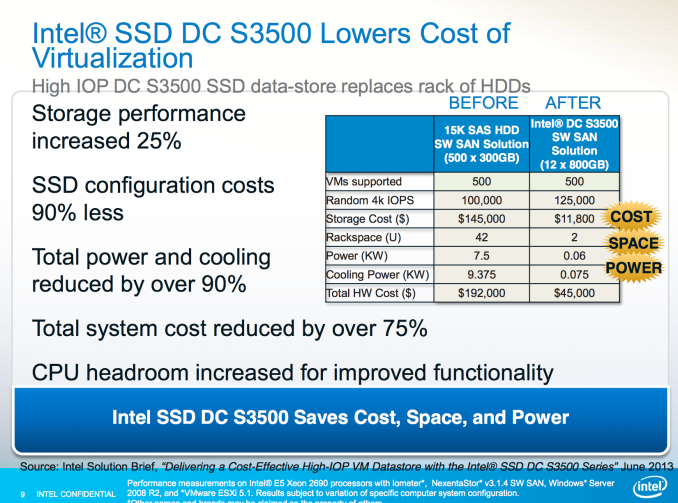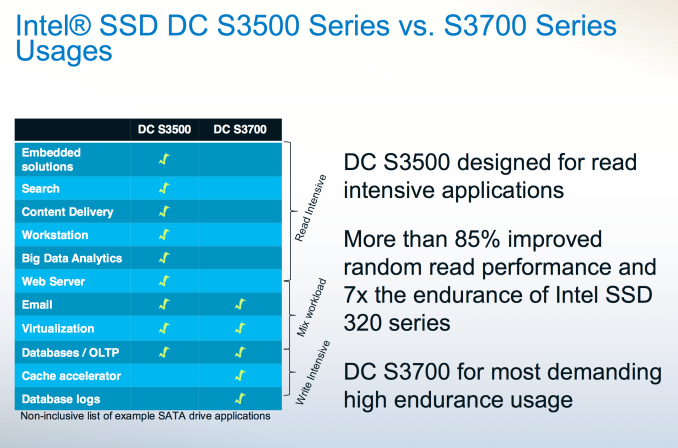Intel SSD DC S3500 Review (480GB): Part 1
by Anand Lal Shimpi on June 11, 2013 6:10 PM EST- Posted in
- Storage
- IT Computing
- SSDs
- Intel
- Datacenter
- Enterprise
Final Words
In our first high level look, Intel's SSD DC S3500 looks to be everything we loved about the S3700 but at a more affordable price point for enterprise customers who don't need insane amounts of write endurance. With SSDs in the enterprise there's this tendency to over estimate endurance needs. I was guilty of it in the design of our SSD requirements for serving AnandTech. Part of the problem is there aren't tons of good software applications to quietly monitor/report/analyze enterprise workload behavior. I suspect that for the vast majority of use cases however, the S3500 is likely more than enough. Even though the AnandTech database servers (content, stats tracking and forums) are fairly write intensive, the S3500 is actually the right target for us - the S3700 would deliver far more endurance than we'd ever use.
Other than write endurance, the only other thing you give up is random write performance. Intel's specs list the S3500 at roughly 1/3 of the sustained 4KB random write performance of the S3700, which I saw in our numbers as well. Given the lower price point however, most customers are likely comparing performance to an array of hard drives. On an individual level, a good high-end HDD will provide somewhere around 1 - 2MB/s in 4KB random write performance. The S3500 by comparison is good for about 40MB/s. Intel's own data shows that 12 S3500s will deliver roughly the same random IO as 500 15K RPM hard drives. Based on the data I've seen, that comparison is pretty accurate.
All of the other S3700 benefits remain. Performance consistency is excellent, which makes the S3500 ideal for use in many-drive RAID arrays. Intel's enterprise drives have typically done very well in terms of reliability as well (and I haven't heard any complaints about the S3700), making the S3500 a safe bet. My only real complaint about this drive is the idle power rating is too high for notebook use, because otherwise I'd even suggest looking at the S3500 for consumer use as well.
All in all I've been pleased with Intel's work in the enterprise SSD space. Most interesting to me is just how aggressive Intel has been in terms of enterprise SSD pricing. The S3500 shows up at well under $1.50/GB, and consumer drives aren't that far off in terms of pricing. Intel typically doesn't push this aggressively for lower prices with its enterprise products, so when it happens I'm very happy.












54 Comments
View All Comments
nathanddrews - Wednesday, June 12, 2013 - link
The difference is that the S3500 comes over provisioned and the others don't. While you and I have the knowledge and skill to do it ourselves, most people - even IT staff - would have zero clue or interest in how to do something like that.zanon - Wednesday, June 12, 2013 - link
Give me a break, "most people" aren't interested in an S3500 period or even a prosumer drive, their primary focus would be capacity and cost (since at that level any modern SSD at all will be great). By definition, anyone interested in this or other such drives isn't "most people". "IT staff" or prosumers can perfectly well format/partition a drive, an easy GUI for it comes with every OS they'd use, it's hardly the kind of technical operation that'd make it a rare case. And since it only ever needs to be done once and then can be ignored forever, it can even be setup by someone else.Anand has considered it important enough to spend significant time on and test in all other recent reviews, and I think that speaks for itself. It's of direct relevance.
cheeselover - Wednesday, June 12, 2013 - link
does increasing overprovising on the intel drive change the performance much? this article compares s3500 to 600 pro but overprovising is much higher on the seagate drive (512gb of flash to get 400gb of storage). the intel drive is listed as 264gb of flash for 240gb and that translate to 512gb of flash for 480gb.also wondering how the pricing works out considering for the same amount of flash the seagate drives get 20% less storage space.
sallgeud - Wednesday, June 12, 2013 - link
As of right now it's been nearly 6 weeks since the last retailer and wholesaler received their shipments of S3700s. The word from most of them is that we're at least 6 more weeks away from the next expected deliveries. For those of us in the server world, it would be great if they could just produce and ship what they already make... and thus far throwing money at my monitor has done nothing.mtoma - Wednesday, June 12, 2013 - link
Regarding the testing methodology: on page 3, Mr. Shimpi said (as usual) the following: "To generate the data below I took a freshly secure erased SSD and filled it with sequential data". Ok, so how EXACTLY he did that? I mean, secure erasing the Intel SSD. I was in a couple of very frustrating positions, when I tried to secure erase Intel and Samsung SSD's, following the kind (read DUMB) suggestions of Samsung SSD Magician and Intel SSD Toolbox. On the Samsung drive I finnaly did it, I secure erased the drive. On Intel, no way. Intel SSD Toolbox kept saing that I must power down the drive, and then power on. But that din't work. I noticed a lot of angry users of Intel SSDs who could not secure erase their drive.So allow me to repeat the question: HOW MR. SHIMPI SECURE ERASED THE DRIVE? Thanks!
alainiala - Wednesday, June 12, 2013 - link
Interesting, the comment about the high idle power usage making this drive not ideal for consumer use... Our channel partner was recommending this as a replacement for the 320 Series for our laptops.mjz - Thursday, June 13, 2013 - link
why would you even have to upgrade the SSDs in the laptops? I think your channel partner is just trying to make some money. The intel 320 ssd when used in a laptop is good for 98% of tasksneodan - Thursday, June 13, 2013 - link
Unrelated question but if you guys had a choice between having the Crucial M500 480GB or the Samsung 830 512GB for the same price which would pick overall?Wolfpup - Thursday, June 13, 2013 - link
I continue to be a firm believer in Micron/Crucial and Intel's drives-quality and reliability and non-flakieness over (sometimes) better performance. ANY decent SSD for years now has provided crazy performance. As far as I'm concerned, that's now a moot point, save for drives that dip super low weirdly.What I care about is reliability and the testing these two companies do compared to other companies. I mean whoopdedo if one company makes an SSD that's 400 bajillion MB/s and another does 400 bajillian + 20 MB/s if the latter is going to corrupt my data after six months.
I've currently got two Intel drives and Crucial in active use (one in my Playstation 3) and all of them have run great with zero issues. Thrilled that Intel's using their own controllers again and not the "we spent an entire year fixing Sandforce's gigantic bugs and it still has gigantic bugs" Sandforce stuff.
Hmm, I guess actually I have a Samsung in my Macbook which has been okay too.
Juddog - Thursday, June 13, 2013 - link
Excellent job Anand! I just hope Intel can keep up with supplying these things; I tried to get my hands on an S3700 after they came out and they were all completely sold out everywhere.